Emission Behaviors of Inorganic Ultrafine Particles during Zhundong Coal Oxy-Fuel Combustion with Characterized Oxygen Input Fractions Comparable to Air Combustion
Abstract
1. Introduction
2. Materials and Methods
2.1. Coal Properties
2.2. Experimental Setup and Sample Analysis
2.3. Calculation of the Char Particle Combustion Temperature
3. Results and Discussion
3.1. Particle Size Distributions (PSDs) of Inorganic PM10 Generated from Zhundong Coal Combustion
3.2. Chemical Compositions of PM10
3.3. Mass Yields of PM10
3.4. Influence of Characterized Oxygen Input Fractions on the Emission of PM0.5 and PM0.5–10
3.4.1. PM0.5
3.4.2. PM0.5–10
4. Conclusions
- (1)
- The emission yield of Zhundong coal is very high and reaches up to 200 mg_PM10/g_ash. It is much higher than other power coal and must be a terrible burden for dust-cleaning apparatuses.
- (2)
- In all cases, inorganic PM0.5 is composed of Na, S, Mg and Ca, with total fractions of ~90%, while PM0.5–10 predominantly contains Ca (~50–65%), and some Mg, S, Al and Si.
- (3)
- At three characterized oxygen fractions during oxy-fuel combustion (OXY21, 27 and 32), the promoted O2 fraction increases the yields of both PM0.5 and PM0.5–10. Higher particle-burning temperatures and lower CO2 fractions promote the reactions of both organically bound elements and minerals, increasing the partitioning of Mg and Ca, and causing an increased yield of PM0.5. The fragmentation of char particles and the melting and coalescence of the included minerals are increased by the higher char combustion temperature to form more PM0.5–10.
- (4)
- The yield of PM0.5 from AIR is high and similar to that from OXY32 while the yield of PM0.5–10 from AIR is similar to the OXY27 case. The high yield of PM0.5 from AIR is mainly caused by the highest yield of Ca in four conditions. The very similar particle-burning temperature of AIR and OXY27 should be responsible for their similar PM0.5–10 yields as there is no apparent impact on the partitioning of individual elements.
Author Contributions
Funding
Acknowledgments
Conflicts of Interest
References
- You, C.; Xu, X. Coal combustion and its pollution control in China. Energy 2010, 35, 4467–4472. [Google Scholar] [CrossRef]
- Xu, M.; Yu, D.; Yao, H.; Liu, X.; Qiao, Y. Coal combustion-generated aerosols: Formation and properties. Proc. Combust. Inst. 2011, 33, 1681–1697. [Google Scholar] [CrossRef]
- Xu, M.; Qiao, Y.; Zheng, C.; Li, L.; Liu, J. Modeling of homogeneous mercury speciation using detailed chemical kinetics. Combust. Flame 2003, 132, 208–218. [Google Scholar] [CrossRef]
- Luo, G.; Yao, H.; Xu, M.; Gupta, R.; Xu, Z. Identifying modes of occurrence of mercury in coal by temperature programmed pyrolysis. Proc. Combust. Inst. 2011, 33, 2763–2769. [Google Scholar] [CrossRef]
- Wen, C.; Gao, X.; Yun, Y.; Wu, J.; Xu, M.; Wu, H. Emission of inorganic PM10 from included mineral matter during the combustion of pulverized coals of various ranks. Fuel 2015, 140, 526–530. [Google Scholar] [CrossRef]
- Lei, M.; Sun, C.; Wang, C. Techno-Economic Analysis of a 600 MW oxy-Enrich pulverized coal-Fired boiler. Energies 2018, 11, 768. [Google Scholar] [CrossRef]
- Zhang, Z.; Zhu, M.; Li, J.; Zhang, K.; Xu, G.; Zhang, D. Experimental study of ignition and combustion characteristics of single particles of Zhundong lignite. Energy Fuels 2017, 32, 4221–4226. [Google Scholar] [CrossRef]
- Kazagic, A.; Hodzic, N.; Metovic, S. Co-combustion of low-rank coal with woody biomass and miscanthus: An experimental study. Energies 2018, 11, 601. [Google Scholar] [CrossRef]
- Khatami, R.; Levendis, Y.A. An overview of coal rank influence on ignition and combustion phenomena at the particle level. Combust. Flame 2016, 164, 22–34. [Google Scholar] [CrossRef]
- Torresi, M.; Fornarelli, F.; Fortunato, B.; Camporeale, S.; Saponaro, A. Assessment against experiments of devolatilization and char burnout models for the simulation of an aerodynamically staged swirled low-NOx pulverized coal burner. Energies 2017, 10, 66. [Google Scholar] [CrossRef]
- Wang, X.; Xu, Z.; Wei, B.; Zhang, L.; Tan, H.; Yang, T.; Mikulčić, H.; Duić, N. The ash deposition mechanism in boilers burning Zhundong coal with high contents of sodium and calcium: A study from ash evaporating to condensing. Appl. Therm. Eng. 2015, 80, 150–159. [Google Scholar] [CrossRef]
- Li, G.; Li, S.; Huang, Q.; Yao, Q. Fine particulate formation and ash deposition during pulverized coal combustion of high-sodium lignite in a down-fired furnace. Fuel 2015, 143, 430–437. [Google Scholar] [CrossRef]
- Wu, X.; Zhang, X.; Yan, K.; Chen, N.; Zhang, J.; Xu, X.; Dai, B.; Zhang, J.; Zhang, L. Ash deposition and slagging behavior of Chinese Xinjiang high-alkali coal in 3 MW th pilot-scale combustion test. Fuel 2016, 181, 1191–1202. [Google Scholar] [CrossRef]
- Zhou, B.; Zhou, H.; Wang, J.; Cen, K. Effect of temperature on the sintering behavior of Zhundong coal ash in oxy-fuel combustion atmosphere. Fuel 2015, 150, 526–537. [Google Scholar] [CrossRef]
- Li, J.; Zhu, M.; Zhang, Z.; Kai, Z.; Shen, G.; Zhang, D. Characterisation of ash deposits on a probe at different temperatures during combustion of a Zhundong lignite in a drop-tube furnace. Fuel Process. Technol. 2016, 144, 155–163. [Google Scholar] [CrossRef]
- Xu, J.; Yu, D.; Fan, B.; Zeng, X.; Lv, W.; Chen, J. Characterization of ash particles from co-combustion with a Zhundong coal for understanding ash deposition behavior. Energy Fuels 2012, 28, 678–684. [Google Scholar] [CrossRef]
- Fuller, A.; Maier, J.; Karampinis, E.; Kalivodova, J.; Grammelis, P.; Kakaras, E.; Scheffknecht, G.; Sciubba, E. Fly Ash formation and characteristics from (co-)combustion of an herbaceous biomass and a Greek lignite (low-rank coal) in a pulverized fuel pilot-Scale test facility. Energies 2018, 11, 1581. [Google Scholar] [CrossRef]
- Buhre, B.J.P.; Elliott, L.K.; Sheng, C.; Gupta, R.P.; Wall, T.F. Oxy-fuel combustion technology for coal-fired power generation. Prog. Energy Combust. Sci. 2005, 31, 283–307. [Google Scholar] [CrossRef]
- Toftegaard, M.B.; Brix, J.; Jensen, P.A.; Glarborg, P.; Jensen, A.D. Oxy-fuel combustion of solid fuels. Prog. Energy Combust. Sci. 2010, 36, 581–625. [Google Scholar] [CrossRef]
- Lei, K.; Ye, B.; Cao, J.; Zhang, R.; Liu, D. Combustion characteristics of single particles from bituminous coal and pine sawdust in O2/N2, O2/CO2, and O2/H2O atmospheres. Energies 2017, 10, 1695. [Google Scholar] [CrossRef]
- Guo, J.; Liu, Z.; Huang, X.; Zhang, T.; Luo, W.; Hu, F.; Li, P.; Zheng, C. Experimental and numerical investigations on oxy-coal combustion in a 35 MW large pilot boiler. Fuel 2017, 187, 315–327. [Google Scholar] [CrossRef]
- Molina, A.; Shaddix, C.R. Ignition and devolatilization of pulverized bituminous coal particles during oxygen/carbon dioxide coal combustion. Proc. Combust. Inst. 2007, 31, 1905–1912. [Google Scholar] [CrossRef]
- Yu, D.; Morris, W.J.; Erickson, R.; Wendt, J.O.L.; Fry, A.; Senior, C.L. Ash and deposit formation from oxy-coal combustion in a 100 kW test furnace. Int. J. Greenh. Gas Control 2011, 5, S159–S167. [Google Scholar] [CrossRef]
- Morris, W.J.; Yu, D.; Wendt, J.O.L. Soot, unburned carbon and ultrafine particle emissions from air and oxy-coal flames. Proc. Combust. Inst. 2011, 33, 3415–3421. [Google Scholar] [CrossRef]
- Suriyawong, A.; Gamble, M.; Lee, M.; Axelbaum, R.A.; Biswas, P. Submicrometer particle formation and mercury speciation under O2−CO2 coal combustion. Energy Fuels 2006, 20, 2357–2363. [Google Scholar] [CrossRef]
- Sheng, C.; Li, Y.; Liu, X.; Yao, H.; Xu, M. Ash particle formation during O2/CO2 combustion of pulverized coals. Fuel Process. Technol. 2007, 88, 1021–1028. [Google Scholar] [CrossRef]
- Sheng, C.; Li, Y. Experimental study of ash formation during pulverized coal combustion in O2/CO2 mixtures. Fuel 2008, 87, 1297–1305. [Google Scholar] [CrossRef]
- Kazanc, F.; Levendis, Y.A. Physical properties of particulate matter emitted from combustion of coals of various ranks in O2/N2 and O2/CO2 environments. Energy Fuels 2012, 26, 7127–7139. [Google Scholar] [CrossRef]
- Kazanc, F.; Levendis, Y.A.; Maffei, T. Chemical composition of submicrometer particulate matter (PM1) emitted from combustion of coals of various ranks in O2/N2 and O2/CO2 environments. Energy Fuels 2013, 27, 4984–4998. [Google Scholar] [CrossRef]
- Jia, Y.; Lighty, J.S. Ash particulate formation from pulverized coal under oxy-fuel combustion conditions. Environ. Sci. Technol. 2012, 46, 5214–5221. [Google Scholar] [CrossRef] [PubMed]
- Liu, X.; Xu, M.; Hong, Y.; Yu, D.; Gao, X.; Cao, Q.; Cai, Y. Effect of combustion parameters on the emission and chemical composition of particulate matter during coal combustion. Energy Fuels 2007, 21, 157–162. [Google Scholar] [CrossRef]
- Zeng, X.; Yu, D.; Liu, F.; Fan, B.; Wen, C.; Yu, X.; Xu, M. Scavenging of refractory elements (Ca, Mg, Fe) by kaolin during low rank coal combustion. Fuel 2018, 223, 198–210. [Google Scholar] [CrossRef]
- Wang, C.; Jin, X.; Wang, Y.; Yan, Y.; Cui, J.; Liu, Y.; Che, D. Release and transformation of sodium during pyrolysis of Zhundong coals. Energy Fuels 2015, 29, 78–85. [Google Scholar] [CrossRef]
- Wen, C.; Xu, M.; Zhou, K.; Yu, D.; Zhan, Z.; Mo, X. The melting potential of various ash components generated from coal combustion: Indicated by the circularity of individual particles using CCSEM technology. Fuel Process. Technol. 2015, 133, 128–136. [Google Scholar] [CrossRef]
- Wen, C.; Gao, X.; Xu, M. A CCSEM study on the transformation of included and excluded minerals during coal devolatilization and char combustion. Fuel 2016, 172, 96–104. [Google Scholar] [CrossRef]
- Wang, C.; Liu, X.; Li, D.; Wu, W.; Xu, Y.; Si, J.; Zhao, B.; Xu, M. Effect of H2O and SO2 on the distribution characteristics of trace elements in particulate matter at high temperature under oxy-fuel combustion. Int. J. Greenh. Gas Control 2014, 23, 51–60. [Google Scholar] [CrossRef]
- Wen, C.; Zhang, P.; Yu, D.; Gao, X.; Xu, M. Loading identical contents of sodium and quartz into different ash-removed coals to elaborately investigate the real effects of coal particle combustion on the emission behavior of PM10. Proc. Combust. Inst. 2017, 36, 2191–2198. [Google Scholar] [CrossRef]
- Gao, X.; Rahim, M.U.; Chen, X.; Wu, H. Inorganic PM10 emission from the combustion of individual mallee components and whole-tree biomass. Proc. Combust. Inst. 2017, 36, 3313–3319. [Google Scholar] [CrossRef]
- Gao, X.; Wu, H. Effect of sampling temperature on the properties of inorganic particulate matter collected from biomass combustion in a drop-tube furnace. Energy Fuels 2010, 24, 4571–4580. [Google Scholar] [CrossRef]
- Wen, C.; Xu, M.; Yu, D.; Sheng, C.; Wu, H.; Zhang, P.A.; Qiao, Y.; Yao, H. PM10 formation during the combustion of N2-char and CO2-char of Chinese coals. Proc. Combust. Inst. 2013, 34, 2383–2392. [Google Scholar] [CrossRef]
- Sheng, C. Char structure characterised by Raman spectroscopy and its correlations with combustion reactivity. Fuel 2007, 86, 2316–2324. [Google Scholar] [CrossRef]
- Khatami, R.; Stivers, C.; Joshi, K. Combustion behavior of single particles from three different coal ranks and from sugar cane bagasse in O2/N2 and O2/CO2 atmospheres. Combust. Flame 2012, 159, 1253–1271. [Google Scholar] [CrossRef]
- Yu, D.; Xu, M.; Yao, H.; Sui, J.; Liu, X.; Yu, Y.; Cao, Q. Use of elemental size distributions in identifying particle formation modes. Proc. Combust. Inst. 2007, 31, 1921–1928. [Google Scholar] [CrossRef]
- Quyn, D.M.; Wu, H.; Li, C.Z. Volatilisation and catalytic effects of alkali and alkaline earth metallic species during the pyrolysis and gasification of Victorian brown coal. Part I. Volatilisation of Na and Cl from a set of NaCl-loaded samples. Fuel 2002, 81, 143–149. [Google Scholar] [CrossRef]
- Mcnallan, M.J.; Yurek, G.J.; Elliott, J.F. The formation of inorganic particulates by homogeneous nucleation in gases produced by the combustion of coal. Combust. Flame 1981, 42, 45–60. [Google Scholar] [CrossRef]
- Biswas, P.; Wu, C.Y. Control of toxic metal emissions from combustors using sorbents: A review. J. Air Waste Manag. Assoc. 1998, 48, 113–127. [Google Scholar] [CrossRef] [PubMed]
- Neville, M.; Sarofim, A.F. The stratified composition of inorganic submicron particles produced during coal combustion. Symp. (Int.) Combust. 1982, 19, 1441–1449. [Google Scholar] [CrossRef]
- Fuertes, A.B.; Velasco, G.; Alvarez, T.; Fernandez, M.J. Sulfation of dolomite particles at high CO2 partial pressures. Thermochim. Acta 1995, 254, 63–78. [Google Scholar] [CrossRef]
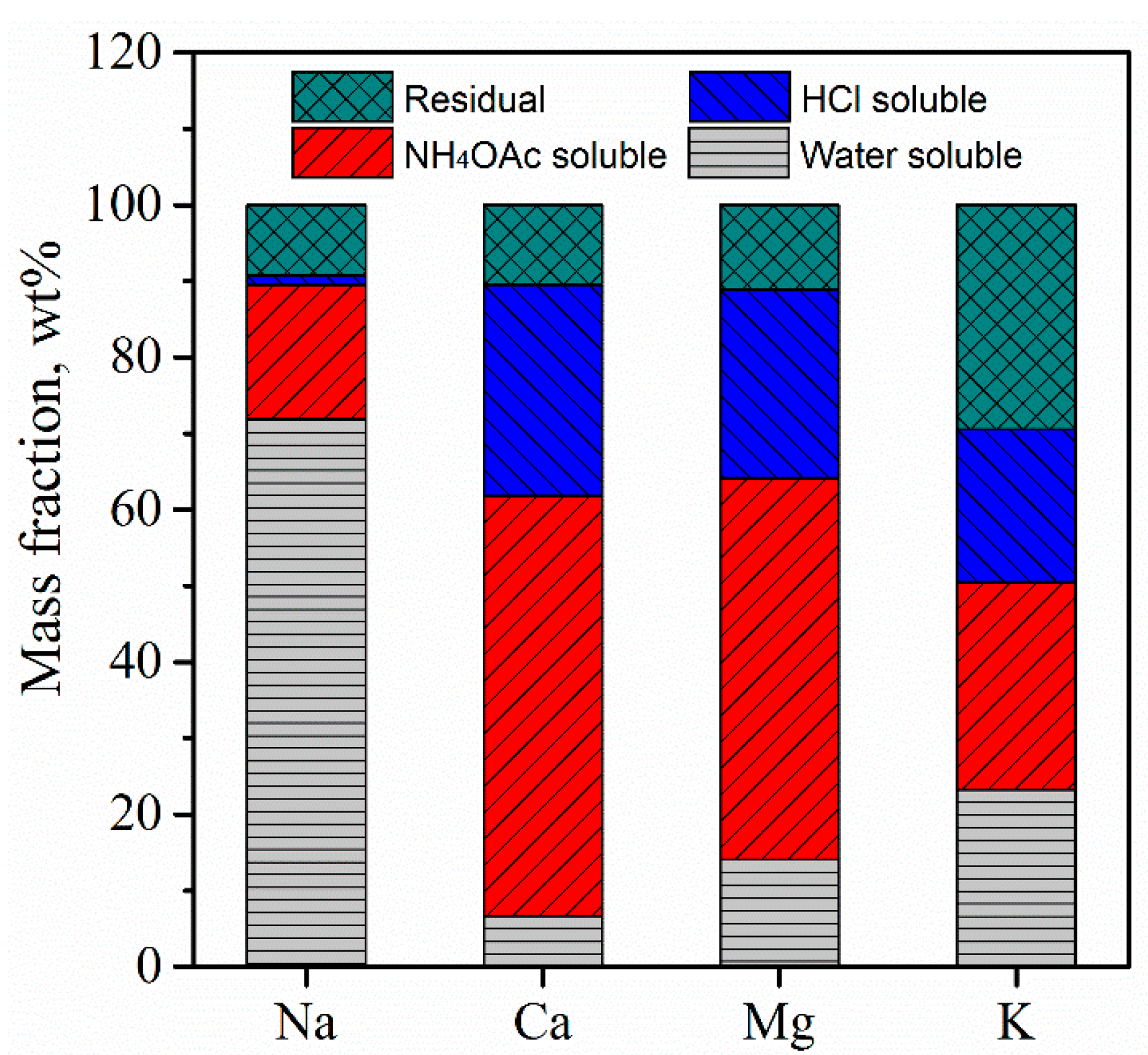
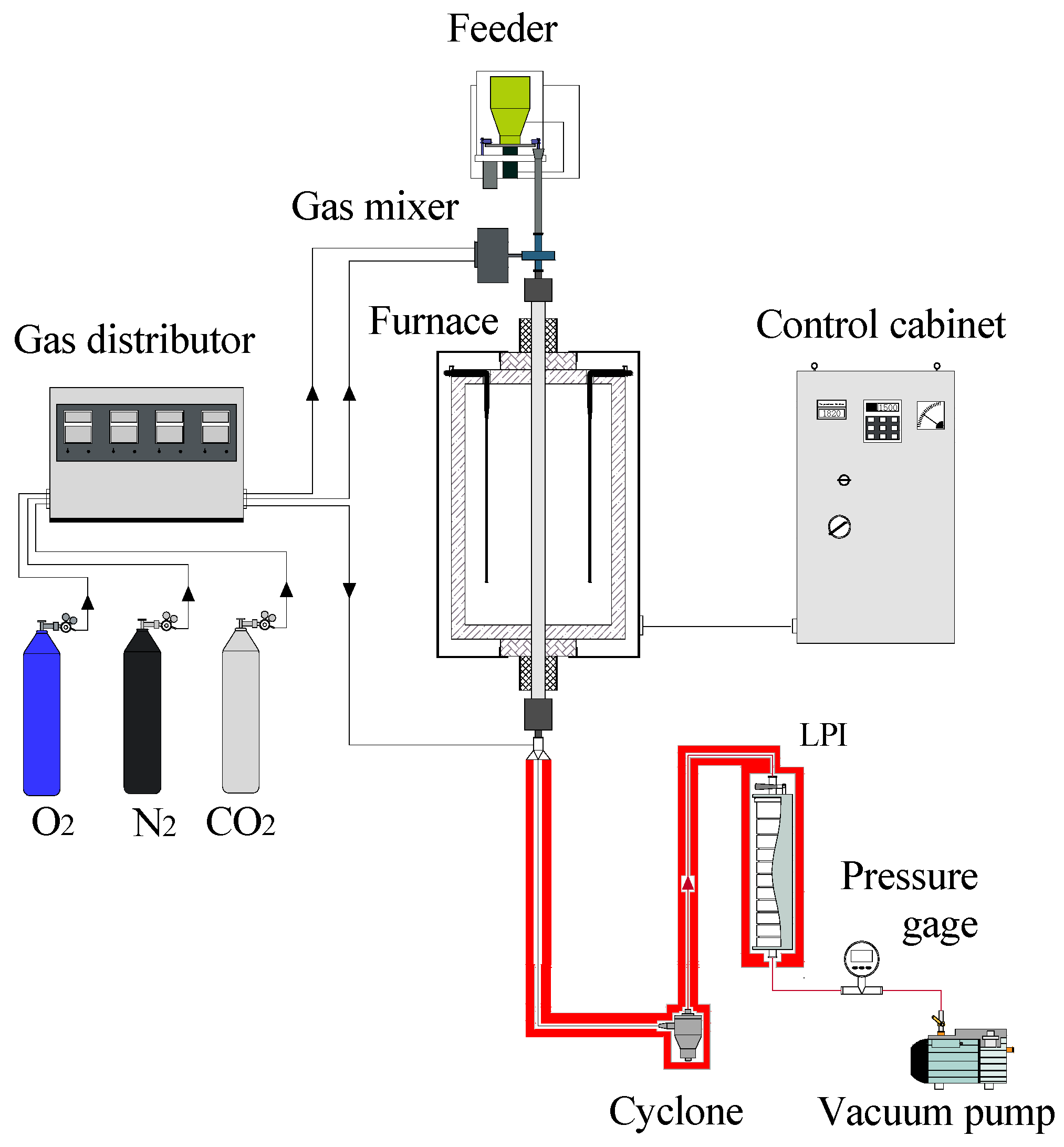
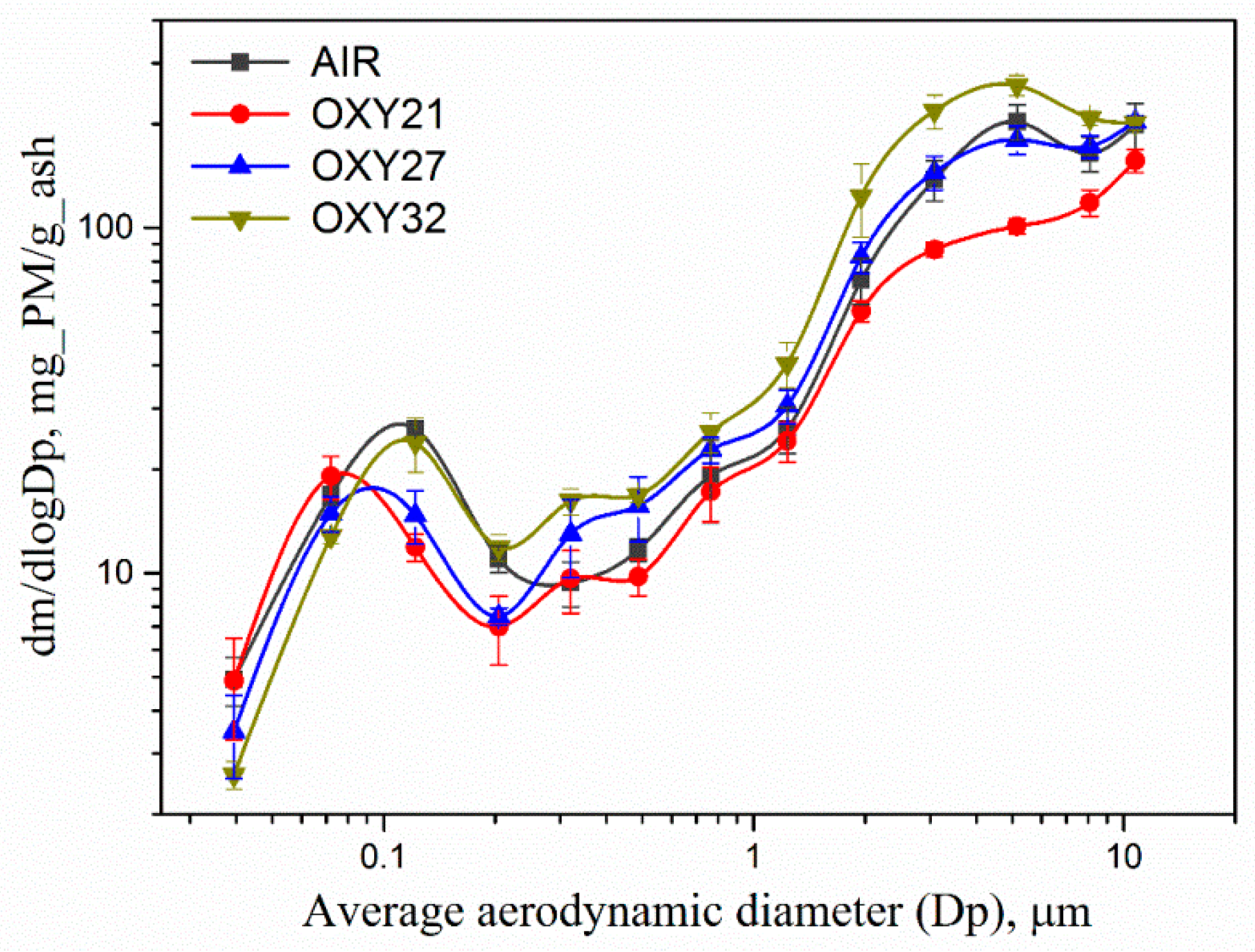
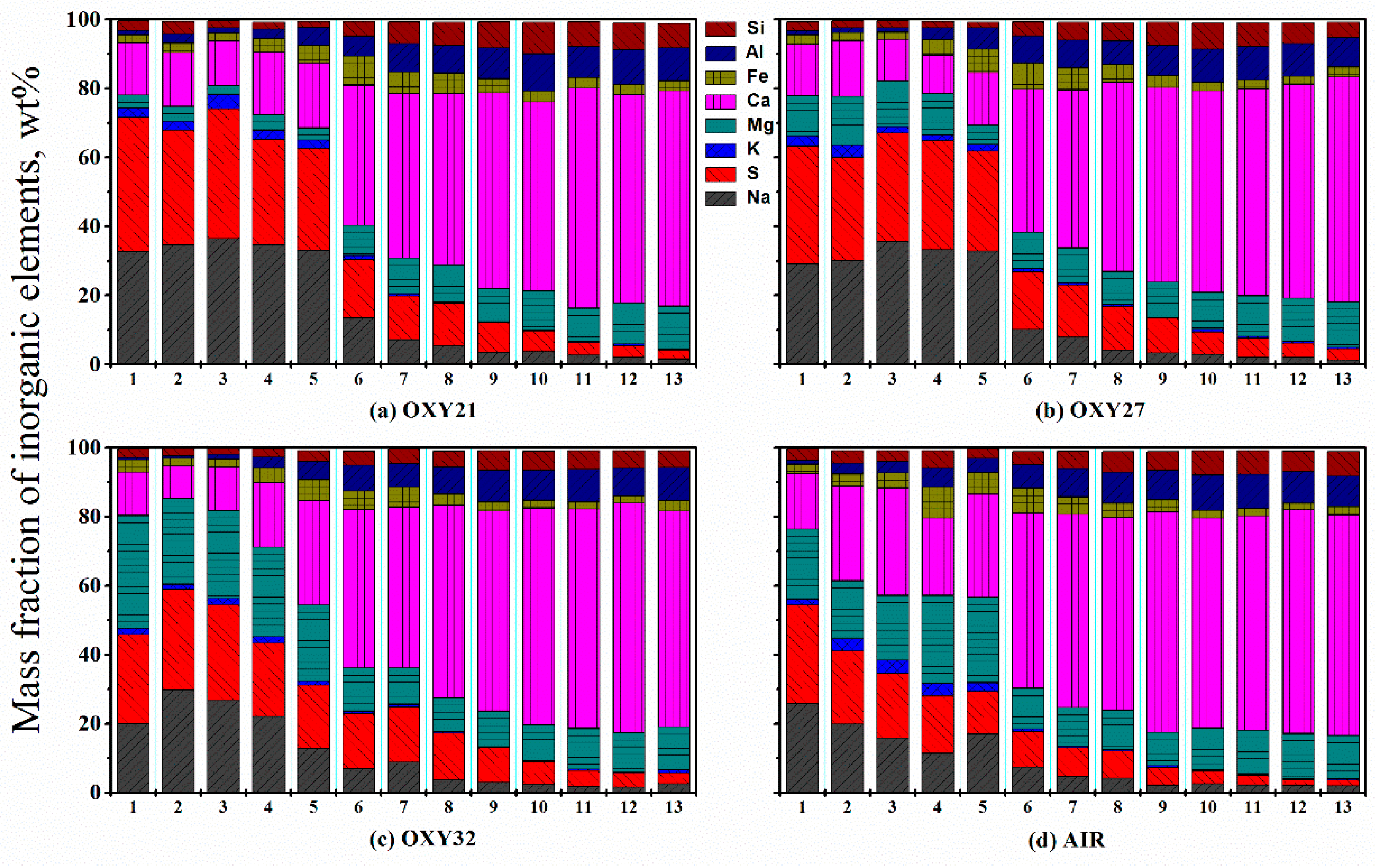
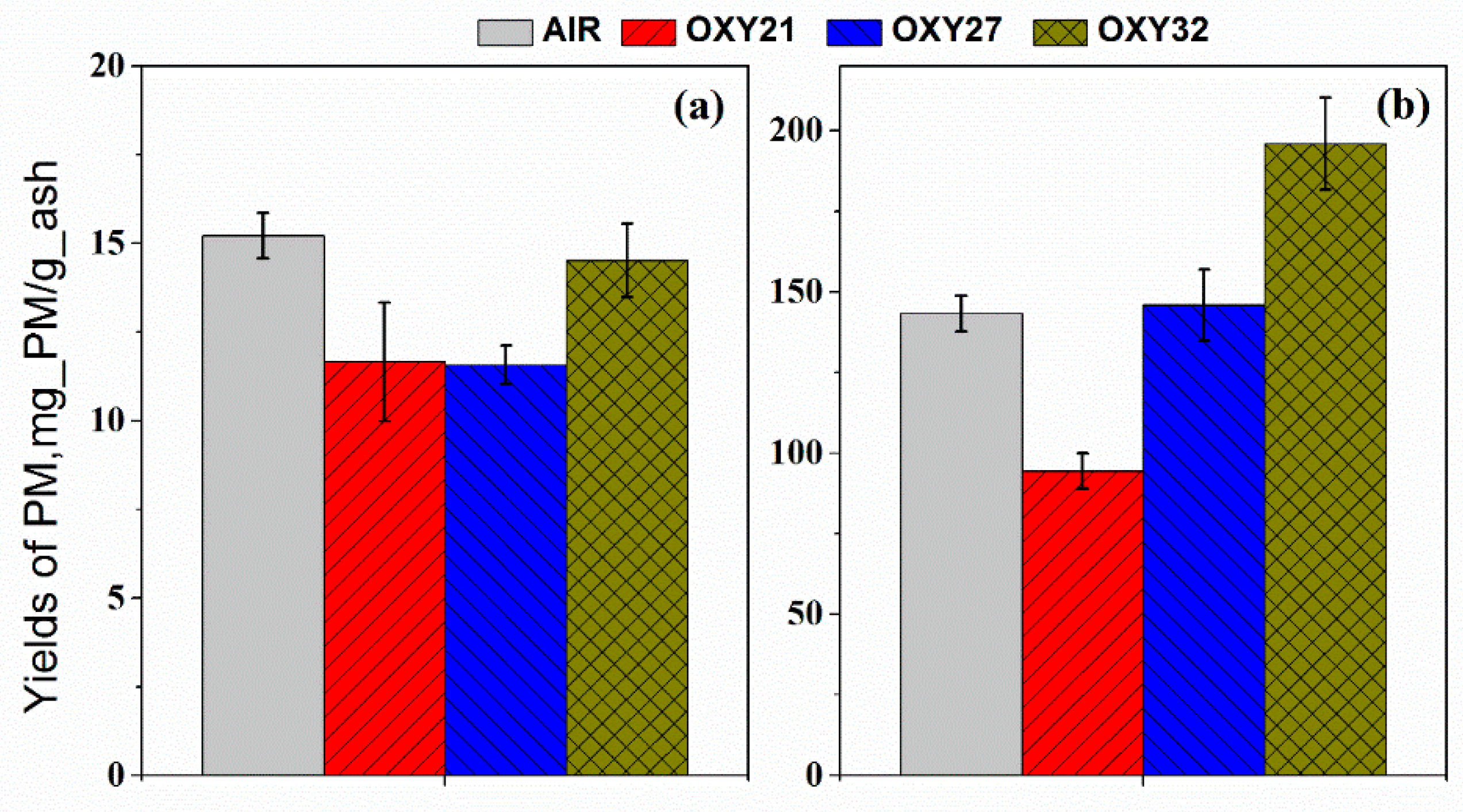
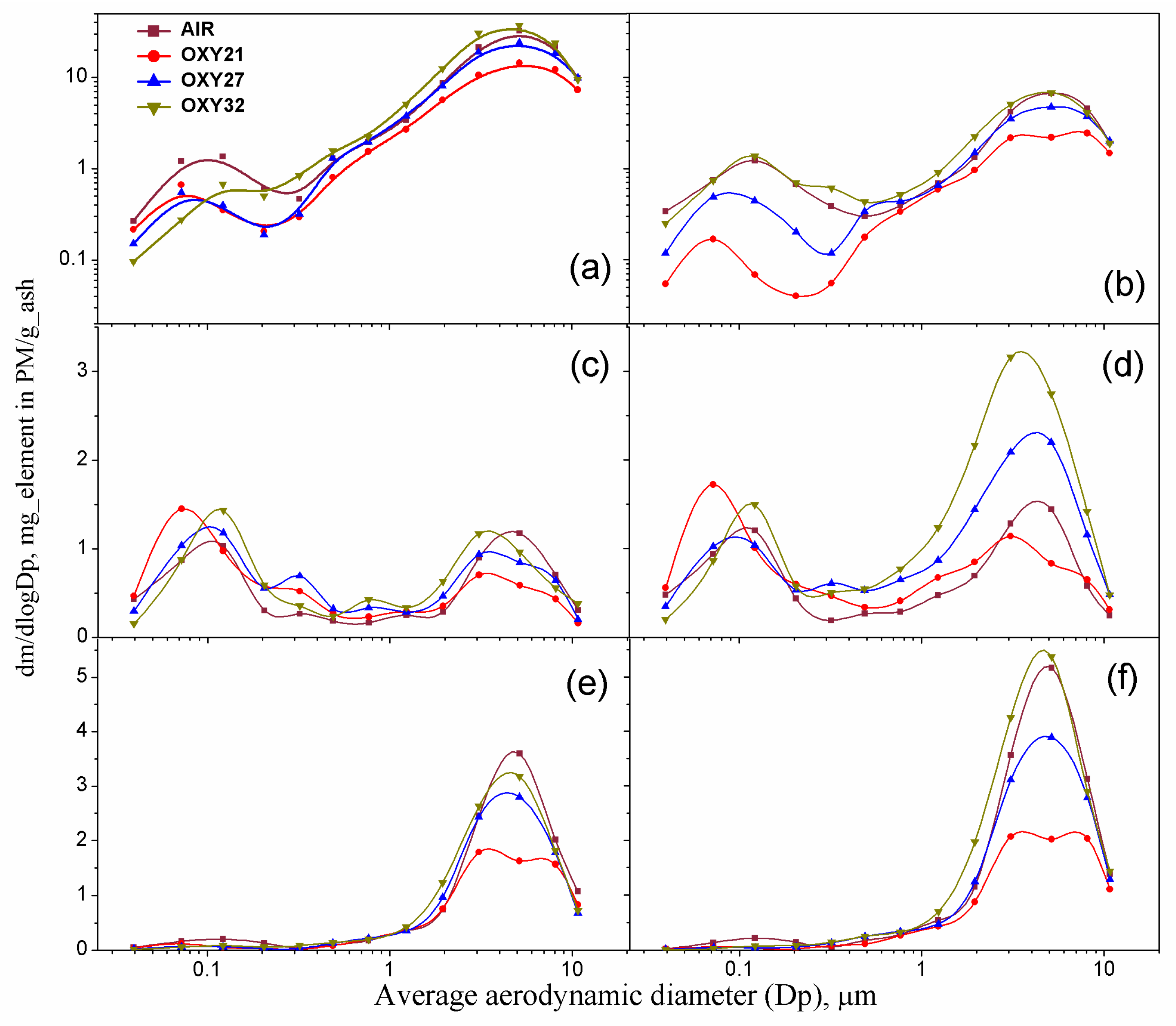
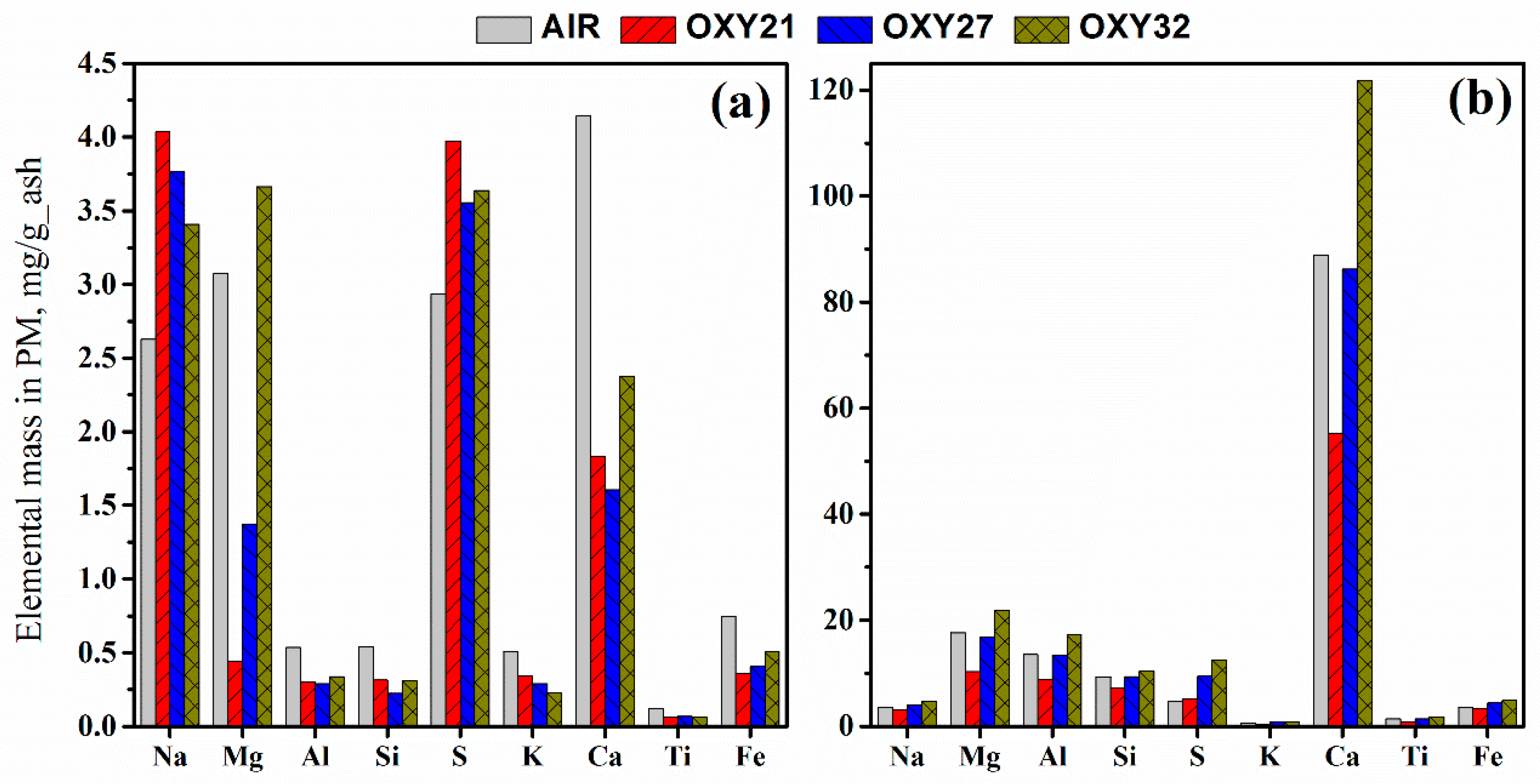

| Coal Type | Furnace Temperature | O2 Fractions in O2/CO2 Combustion | Results as the Increase of O2 Fraction | References |
|---|---|---|---|---|
| PRB sub-bit 1 | 1200 °C | 20, 25, 40, 50%, versus air | Geometric mean size of the submicron particles (PM1) increased because the higher particle surface temperature of the coal resulted in faster mineral vaporization rates. | Suriyawong et al. [25] |
| Three Chinese bituminous coals | 1400 °C | 20, 40%, versus air | Promoted impacts on the formation of fine ash particles in both the submicron mode and the fine fragmentation mode. | Sheng et al. [26,27] |
| PSOC-1451 sub-bit, DECS-26 bit 2, PSOC-1443 lignite | 1127 °C | 30, 40, 60%, versus air | Submicrometer particle emission yields increase and the composition of the ultrafine PM was affected; submicrometer ash yields of lower rank coals were more affected; no clear trend for the fine fragmentation mode. | Kazanc et al. [28,29] |
| Utah bit, Illinois bit, PRB sub-bit | 1137 °C, 1247 °C | 21, 31.5%, versus air | Diameter and mass for the coarse particles did not change, while those for PM0.1 increased. | Jia et al. [30] |
| Utah bit, Illinois bit, PRB sub-bit | <1100 °C | 21, 27, 32%, versus air | Nucleation modes for the Utah and PRB coals were shown to consist of significant amounts of soot; no clear trend for the central mode (i.e., fine fragmentation mode). | Morris et al. [24] Yu et al. [23] |
| Zhundong Coal | Proximate analysis (wt %, air-dried) | Ultimate analysis (wt %, air-dried) | |||||||
| M 1 | A 2 | VM 3 | FC 4 | C | H | O 5 | N | S | |
| 7.25 | 3.56 | 40.13 | 49.06 | 65.77 | 3.95 | 14.60 | 4.36 | 0.51 | |
| Zhundong Coal | Chemical composition analysis of low-temperature ashes (wt %) | ||||||||
| Na2O | K2O | SO3 | CaO | Fe2O3 | MgO | Al2O3 | SiO2 | ||
| 4.30 | 0.51 | 26.92 | 37.96 | 3.89 | 10.66 | 8.76 | 7.00 | ||
| Atmosphere | AIR | OXY21 | OXY27 | OXY32 |
|---|---|---|---|---|
| Char temperature (°C) | 1797 | 1741 | 1804 | 1852 |
© 2018 by the authors. Licensee MDPI, Basel, Switzerland. This article is an open access article distributed under the terms and conditions of the Creative Commons Attribution (CC BY) license (http://creativecommons.org/licenses/by/4.0/).
Share and Cite
Fan, B.; Wen, C.; Zeng, X.; Wu, J.; Yu, X. Emission Behaviors of Inorganic Ultrafine Particles during Zhundong Coal Oxy-Fuel Combustion with Characterized Oxygen Input Fractions Comparable to Air Combustion. Appl. Sci. 2018, 8, 1486. https://doi.org/10.3390/app8091486
Fan B, Wen C, Zeng X, Wu J, Yu X. Emission Behaviors of Inorganic Ultrafine Particles during Zhundong Coal Oxy-Fuel Combustion with Characterized Oxygen Input Fractions Comparable to Air Combustion. Applied Sciences. 2018; 8(9):1486. https://doi.org/10.3390/app8091486
Chicago/Turabian StyleFan, Bin, Chang Wen, Xianpeng Zeng, Jianqun Wu, and Xin Yu. 2018. "Emission Behaviors of Inorganic Ultrafine Particles during Zhundong Coal Oxy-Fuel Combustion with Characterized Oxygen Input Fractions Comparable to Air Combustion" Applied Sciences 8, no. 9: 1486. https://doi.org/10.3390/app8091486
APA StyleFan, B., Wen, C., Zeng, X., Wu, J., & Yu, X. (2018). Emission Behaviors of Inorganic Ultrafine Particles during Zhundong Coal Oxy-Fuel Combustion with Characterized Oxygen Input Fractions Comparable to Air Combustion. Applied Sciences, 8(9), 1486. https://doi.org/10.3390/app8091486




